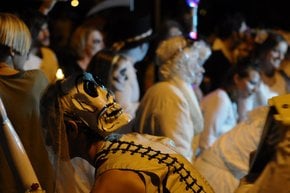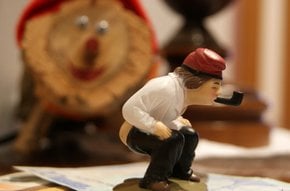La Castanyada 2026 in Barcelona
A family-oriented holiday to commemorate the dead relatives and celebrate the harvest
Dates: October 30–November 1
La Castanyada, celebrated on the evening of October 31st and All Saint's Day, November 1st, is a traditional autumn holiday in Catalonia. On this day, people honor deceased relatives and loved ones by gathering with family and friends to enjoy chestnuts, sweet potatoes, panellets (small sweets), and preserved fruit.
Castanyes & Food Traditions
In Catalunya, castanyada is marked by special sweets such as castanyes (roasted chestnuts) and panellets (marzipan balls covered with pine nuts). Roasted sweet potatoes, candied fruit, quince, and ossos de sant (saint's bones cookies) also feature prominently. These treats are enjoyed with moscatell or other sweet wines, sometimes served in traditional porrons. Freshly-roasted chestnuts are available from street vendors in the Old City (Ciutat Vella) and central Plaça de Catalunya. At the same time, panellets can be made at home or purchased from Barcelona's pastry shops and bakeries.
Traditional Celebrations
The figure of la castanyera, a chestnut roaster dressed as a peasant with gloves and a scarf for warmth, symbolizes the castanyada holiday, with sculptures of her adorning many Spanish towns and villages. In Barcelona, some locals believe that la Castanyera has eight legs. Schools often display a life-sized image of her in a long skirt with eight legs, cutting off one leg each week and throwing it into a fire. This ritual starts on the first day of Castanyada and is intended to coincide with the arrival of los Reyes Magos (the Three Wise Men).
For those looking to combine seasonal treats with Halloween fun, several public celebrations around October 31st offer festive options. Can Ferrero Gardens hosts a family-friendly castanyada, the Nou Barris district celebrates with a week of events, La Pedrera features a children's Castanyera, Trinitat Vella dares visitors with a "tunnel of terror," and Tibidabo presents the Wihelm Freak Show. Barcelona’s Poble Espanyol also offers fun for all ages.
Origins of La Castanyada
Though often called the "Catalan Halloween" because it occurs on October 31st, the castanyada (or castañada) has roots in the Gaelic festival of Samhain. Celebrated in Catalunya, northern Spain, and parts of the Canary Islands, it marks the end of summer and the beginning of winter while honoring the dead. The tradition is linked to All Saints' Day (November 1st), which the Celtic calendar used to mark the new year. While its exact origins and the reasons for specific foods like chestnuts and sweet potatoes are unclear, some believe the tradition stems from 18th-century funereal meals or from stocking up on autumn's first harvest to remember the dead.





















































